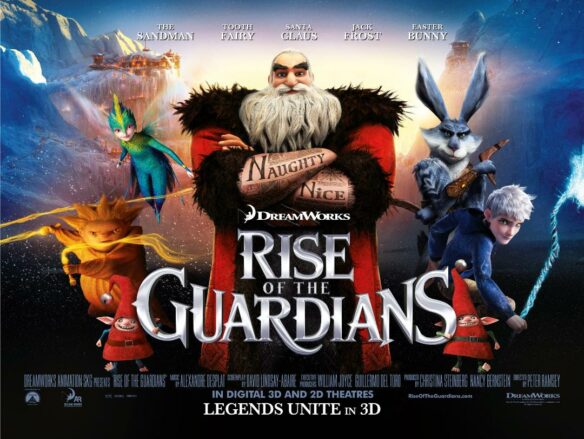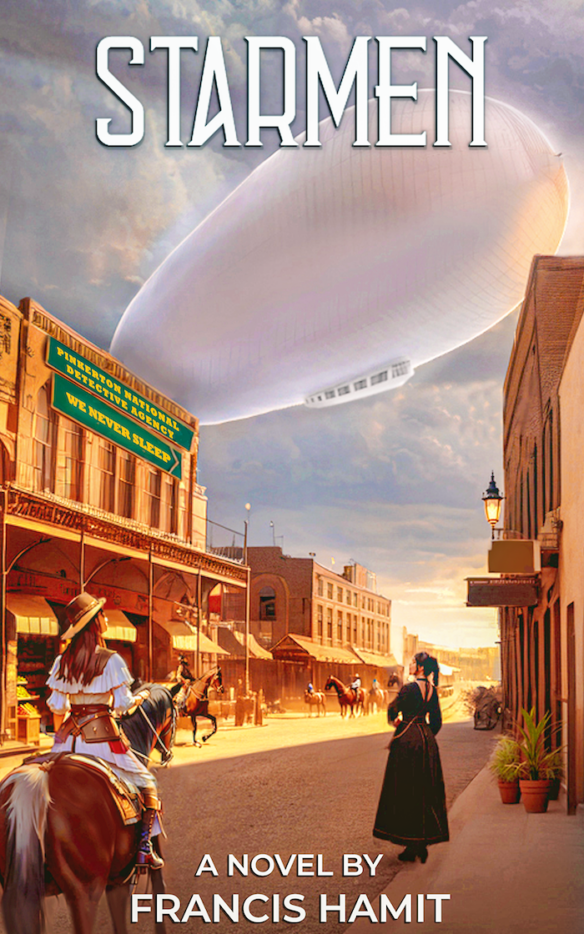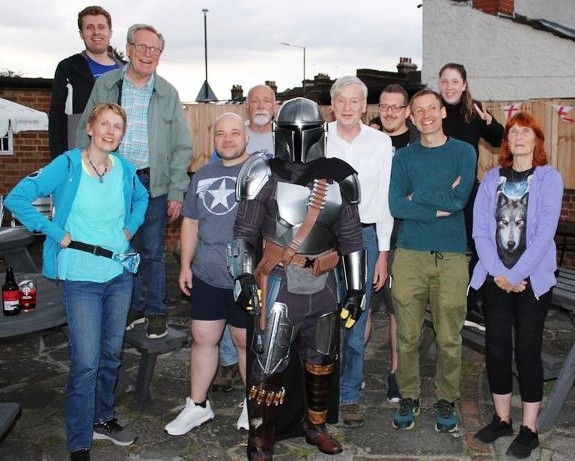(1) NATIONAL BOOK AWARDS. No winners of genre interest, but omnivorous readers will want to know who received the 2024 awards. Publishers Weekly led its coverage with a joke from the ceremony:
…[L]ongtime Saturday Night Live cast member Kate McKinnon, [was] the evening’s host. “I’m a book awards virgin, so be gentle,” she joked before opening her remarks, appropriately for 2024, with a bit about AI. “Books do more than entertain—they illuminate, they provoke, and, most importantly, they inspire change,” she said. “That was written by CHatGPT. Is that bad?”…
- YOUNG PEOPLE’S LITERATURE: Shifa Saltagi Safadi, Kareem Between (G.P. Putnam’s Sons Books for Young Readers / Penguin Random House)
- TRANSLATED LITERATURE: Yáng Shuāng-zǐ, Taiwan Travelogue. Translated from the Mandarin Chinese by Lin King (Graywolf Press)
- POETRY: Lena Khalaf Tuffaha, Something About Living (University of Akron Press)
- NONFICTION: Jason De León, Soldiers and Kings: Survival and Hope in the World of Human Smuggling (Viking Books / Penguin Random House)
- FICTION: Percival Everett, James (Doubleday / Penguin Random House)
(2) WHY DID THEY SAY THAT? T. R. Napper side-eyes “Five Pieces of Awful Writing Advice (from the masters)”. And by masters, we mean Stephen King, Robert Heinlein, Charles Bukowski, Ernest Hemingway, and Elmore Leonard. First on his hit parade:
Don’t keep a notebook (Stephen King)
“I think a writer’s notebook is the best way in the world to immortalise bad ideas. My idea about a good idea is one that sticks around and sticks around.”
Terrible advice, for one simple reason: none of the rest of us are Stephen King. He’s written around 70 books. He writes and writes and writes. Squashed by a fucken van, six weeks in hospital, dusts himself off, keeps writing. Apparently sits down and churns out 6 pages (1500 words) a day, every day, no problem. In terms of idea generation he is a phenomenon. He’s not like you or me.
Don’t get me wrong – ideas will come for the writer. They always do, whether you wish them to or not. But you should write them down. I absolutely have a document where I keep all my big ideas that one day might (or might not) become a short story or a novel. When I go back and look through it every few months, I’ll see some truly stupid thoughts, but I’ll also see a few where I think: I’d forgotten about that. Let’s try it.
(3) WICKED GOOD. The Hollywood Reporter critic David Rooney weighs in with “’Wicked’ Review: Cynthia Erivo and Ariana Grande in Beloved Musical”.
… The respective casting of those roles — Ariana Grande as the minimally gifted sorcery student who will go on to become Glinda, Good Witch of the North, and Cynthia Erivo as Elphaba, future Wicked Witch of the West — is the movie’s winning hand. Their vocals are clear and strong and supple to a degree many of us have learned not to expect after too many movie musicals that cast merely adequate singers and then Auto-Tune them to death.
Grande and Erivo give Stephen Schwartz’s songs — comedy numbers, introspective ballads, power anthems — effortless spontaneity. They help us buy into the intrinsic musical conceit that these characters are bursting into song to express feelings too large for spoken words, not just mouthing lyrics and trilling melodies that someone spent weeks cleaning up in a studio. The decision to record the songs live on set whenever possible is a major plus….
(4) TIMELESS AND TOPICAL. “Jon M. Chu Embraced the Politics of ‘Wicked’ and Audiences Seeing It Through a Post-Election Lens” on IndieWire.
…[Director Jon M.] Chu embraces that his movie will take on a new layer of meaning for many audience members after the re-election of Trump, but noted that impact is in part because politics has been baked into “Wicked” since its inception. Gregory Maguire’s 1995 book “Wicked” is a meditation on resisting fascist movements, a not-so-subtle theme that carried into its musical adaptation by Stephen Schwartz and Winnie Holzman. A major underlying storyline of “Wicked” is how leaders, who claim to have the people’s best interest at heart, attack the educated — represented by professor Dr. Dillamond, a talking goat voiced by Peter Dinklage — as they try to rewrite the history of animals and humans co-existence in an effort to strip the animals of their rights, and demonize them as the source of the people’s problems.
Through this lens, Chu acknowledged his film is prophetic, but only because the underlying IP is prophetic. Chu argued the original “Wizard of Oz” movie — released on the heels of the 1930s Dust Bowl (the drought-stricken storms of the Depression), during the rise of fascism, and on the eve of World War II — has always spoken to America in a time of transition. He personally experienced it at two very different political moments that “Wicked” entered his life….
(5) TERMINAL JUSTICE. “How Do You Punish a Machine? (And why would you want to?)” asks Graham Brown at CrimeReads.
…For their wisdom we turn to the ever-instructive eyes of the science fiction writers of the world.
Starting with 2001: A SPACE ODYSSEY by Arthur C. Clarke, the classic example of machines becoming sentient, in which HAL9000 commits multiple homicides, wiping out the sleeping crewmen of the Discovery, and then eventually attempts to murder the last surviving astronaut Dave by locking him out of the airlock. Quite a set of crimes. But in HAL’s defense, he’d been given conflicting programming and told to lie, factors that many believe caused him to lose his electronic mind. In addition, he may have been under the influence of the mysterious monolith. HAL might also raise a claim of self-defense. At the time he tried to kill Dave, he knew Dave was intending to disconnect him and shut him down.
Interesting case. A good lawyer could make an argument for not guilty by reason of insanity and self-defense, but I’m going to say guilty. To his credit, HAL becomes normal again and sacrifices himself for the crew in 2010 ODYSSEY TWO, perhaps atoning for his terrible crimes…
(6) WHERE PROPHETS ARE WITHOUT HONOR. Cora Buhlert deconstructs the popularity of German band Kraftwerk while simultaneously demythologizing the Autobahn in “A Baffled Guardian Writer Discovers the Autobahn – and the Best German Roadtrip Songs” – an entertaining read!
…This is also where the problem with foreigners driving on the Autobahn comes in. They’re often driving an unfamiliar car, they’re not used to high speeds and also don’t know where and when it’s reasonably safe to go fast. See Tim Jonze starting his Autobahn adventure in the Rhine-Ruhr metropolitan area, where it’s definitely not safe to go fast (and not allowed either). At one point, Jonze also opens the driver’s side window, while going 150 kilometers per hour, which makes me wonder if he’s fucking crazy.
What’s even more hilarious is that while Kraftwerk were on the road a lot in the 1970s, travelling from gig to gig, usually on the Autobahn, often by night, their car was a Volkswagen Beetle. Tim Jonze has apparently never driven a Volkswagen Beetle, but I have, because my parents had one in the 1970s and early 1980s. So I know that they couldn’t go any faster than 130 kilometers per hour and the car started rattling like crazy at approx. 100 kilometers per hour. The Beetle‘s successor, a 1980 Volkswagen Jetta, which I continued to drive until 2008 (I wanted to keep it to hit the thirty year mark, when a car is considered a historical vehicle in Germany and gets a special licence plate, but unfortunately the Jetta fell apart two years before), capped out at 160 kilometers per hour and also started to rattle like mad at anything above 130 kilometers per hour. So Kraftwerk were travelling at the relatively leisurely pace of approx. 100 kilometers per hour in a Volkswagen Beetle, when they wrote the “Autobahn” song….
(7) OCTOTHORPE. In episode 123 of the Octothorpe podcast, “Infinite Amount of Annual Leave”, John Coxon, Alison Scott, and Liz Batty “don’t have any letters of comment but we do have discussion of the Belfast Eastercon, Reconnect, as well as musings on online convention Back to Our Futures and upcoming Worldcons and Eurocons. Plus, Liz read a book.”
An uncorrected transcript is available at the link.

(8) MEMORY LANE.
[Written by Cat Eldridge.]
Anniversary: Rise of the Guardians (2012)
On this day twelve years ago, The Rise Of The Guardians enjoyed its premiere in limited release with its full one that coming weekend. It is quite possibly my favorite holiday film, though Scrooged, Lion in Winter, The Polar Express are also on the list as well. Oh and the forty year old version of A Christmas Carol starring George C. Scott.
It was directed by Peter Ramsey and produced by Christina Steinberg and Nancy Bernstein from a screenplay by David Lindsay-Abaire. It was based on William Joyce’s The Guardians of Childhood series, a most delightful series indeed.
OK, IT IS TIME FOR A CUP OF HOT CHOCOLATE PREPARED BY THE STEWARDS OF THE POLAR EXPRESS. COME BACK AFTER WE HAVE TOLD THE STORY OF THIS FILM.
The Guardians of Childhood series was a mystical epic of mythological characters fighting darkness to protect childhood dreams. It made very good source material for that aforementioned screenplay by David Lindsay-Abaire in which Jack Frost awakens from a very long nap under the ice with his memory gone to discover everyone has forgotten him.
Meanwhile at the North Pole (splendidly realized here), the Man in the Moon warns Nicholas St. North that Pitch Black (who look a lot Mr. Dark in Bill Willingham’s Fables series) is threatening the children of the world with his nightmares.
He calls E. Aster Bunnymund, the Sandman, and the Tooth Fairy to arms. Each of these is a wonderfully realized character as the Man in the Moon and Nicholas St. North.
A series of truly epic battles to defeat Pitch Black follows lest all the children of the world are permanently beset with nightmares. He is defeated when his own Nightmares sensing he has grown weak drag him down into the Underworld.
DID YOU ENJOY THAT HOT CHOCOLATE? GOOD, COME ON BACK.
The feature starred the voice talents of Hugh Jackman, Jude Law and Isla Fisher among others. I think it was a stellar voice cast and the animation was splendid. I’ve rewatched it several times, and the Suck Fairy sits on the couch sighing, drinking hot chocolate, stroking a Pixel, and saying that it’s too sweet for her to mess with. The holiday season does bring out the soft side of her.
It did exceedingly well at the box office taking in over three hundred million on a budget of one hundred and thirty million according to Box Office Mojo, and about half of the critics really liked it such as Derek Adam’s of Time Out who proclaimed “Rise of the Guardians is an effervescent dose of fantasia that’s pretty hard to dislike. Unless, of course, you’re a cynical grump.” The grumpy ones I’ll not quote, but I’ll just say that Old Nick should give them a lump of coal this season.
The audience rating at Rotten Tomatoes is very healthy eighty percent.
Rise of the Guardians can be rented on Amazon Prime.

(9) COMICS SECTION.
- Free Range is more Sister Act than Hidden Figures.
- F Minus argues math is disrespectful.
- Glasbergen tries the dinosaur excuse.
- Non Sequitur passes the blame.
- Saturday Morning Breakfast Cereal employs desperate measures.
- Off the Mark shows where therapy can go both ways.
(10) THE PAST IS ANOTHER COUNTRY. “In Search of the Moomins in Helsinki: The Enduring Magic of Tove Jannson’s Characters” at Literary Hub. “Christiana Spens Returns to Her Father’s world (and the Beloved Moomin Books)”.
… As we explored Helsinki, perhaps inevitably, I kept thinking of my own father. As we sat in cafes and parks, I wondered which of them he had gone to, which of the museums and islands he had explored. Helsinki felt so familiar that it was as if I had already been here, and yet the more time we spent there, the more I realized that I didn’t know anything about my father’s time here at all.
He had not really told me stories about coming here; he had just gone and come back. I had imagined his times in Helsinki based on the gifts he returned with, the pictures in his books, and later the Moomin stories; but he had not really told me anything himself.
He had written about Alvar Aalto, expressed joy at the sight of herrings or gooseberries or meatballs; I knew he loved the place. He had even tried to build a Finnish summer house, in the same sky blue that was popular here; but he had never been very practical minded, and it had not stood up well to the elements.
Nevertheless, I had lived there for several years as a teenager. Perhaps this experience, living in a weather-beaten wooden Summer House in the woods, is what made Finland itself seem familiar to me, rather than anything my father ever told me about the country.
And yet, now that I was here, I found myself wondering about him anyway; had he gone to Esplanade Park, had he had coffee at Fazer, had he known Rock Church or the Uspenski Cathedral, had he felt this light as I did now? But I didn’t actually know, and I never would; he was not here, only his ghost was.
But the Alvar Aalto buildings were, all the other reminders were. And the Moomins were here, too; in gift shops and cafes, these friendly creatures appeared, giving the whole city the cast of a fairy-tale, along with its mists and sea, its pastel-colored buildings, its ships and cobbled stones….
(11) HUFFIN’ AND PUFFIN. Daisy Ridley answers readers’ questions over at the Guardian: “Daisy Ridley: ‘I made a toilet cake on Bake Off because flushing with the lid up is unhygienic beyond belief’”.
Did those late-night drinking and ceilidh sessions during the filming of The Force Awakens on the Skellig islands in County Kerry give you a taste for old-school, dusty pub culture and creamy stout? Galdove19
I’d never had a Guinness outside Ireland, so I got the good stuff the first time round. We had the sun shining on us every day, which the Irish crew said was unbelievable, although every time I’ve been to Ireland it’s been absolutely glorious. I had to climb about a thousand stairs up Great Skellig. Our unbelievable camera operator had a Steadicam and was climbing up backwards, so I thought: “There’s no way I can complain.” That tamed my own exhaustion. The Skellig islands are an ecological site, so we had to not disturb the puffin population, who were there one day, but had migrated the next, which was eerie and amazing. They obviously weren’t big Star Wars fans and thought: “We’ve had enough of this.”
(12) EXERCISE IN TERROR. [Item by Steven French.] Coming a little late for Halloween: “The health benefits of fright: A haunted house study” at Medical X Press.
…People often engage in activities that elicit fear for recreational purposes, from ghost stories and jump scare pranks to modern horror films and haunted attractions. This haunted house experiment suggests that such experiences may not only provide thrills but also potential health benefits by modulating immune responses.
Further research is needed to confirm the observed effects and explore the mechanisms underlying the relationship between recreational fear and immune function before clinical applications can be considered significant enough to incorporate acute fear into a health care setting….
(13) WHOVILLE’S GOLDEN ARCHES. The Grinch is now in Happy Meal at McDonald’s. So then — are these roast beast nuggets?

(14) JUMPING OUT OF THE WAY. “The International Space Station adjusts its orbit to avoid space debris” – NPR has the details.
NASA says that the International Space Station (ISS) shifted its orbit on Tuesday to avoid a piece of debris.
The debris avoidance maneuver involved firing thrusters on the ISS at 2:09 p.m. CT for 5 minutes, 31 seconds, according to NASA. This adjustment raised the ISS orbit to “provide an extra margin of distance from a piece of orbital debris from a defunct defense meteorological satellite that broke up in 2015,” the agency says.
Had the maneuver not been conducted, the debris would have come within nearly 2.5 miles of the station, NASA also says. The debris was “small,” U.S. Space Forces-Space tells NPR…
(15) INTERNATIONAL STAR WARS SHOW RENEWED. Variety reports, “’Star Wars: Visions’ Series to Return for Third Season”.
“Star Wars: Visions,” a Lucasfilm anthology series of animated shorts from around the world celebrating the mythology of Star Wars through different cultural perspectives, will return for a third season, Marvel Studios’ president Kevin Feige said on Wednesday.
Feige was a surprise guest at the annual Walt Disney Company Asia Pacific Showcase held in Singapore.
“Star Wars: Visions Volume 3” will debut in 2025 on the Disney+ streaming service. The upcoming series will feature both new and returning anime studios, and return to Japan to celebrate the world of anime through the elements and mythos of Star Wars….
(16) VIDEO OF THE DAY. Ryan George takes us inside the “Red One Pitch Meeting”.
[Thanks to Mike Kennedy, Andrew Porter, John King Tarpinian, N., Chris Barkley, Cat Eldridge, SF Concatenation’s Jonathan Cowie, Steven French, Kathy Sullivan, and Teddy Harvia for some of these stories. Title credit belongs to File 770 contributing editor of the day Dan’l.]






















































